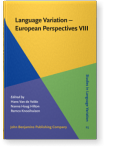Chapter 4
Modeling regional variation in voice onset time of Jutlandic varieties of Danish
It is a well-known overt feature of the Northern Jutlandic variety of Danish that /t/ is pronounced with short voice onset time and no affrication. This is not limited to Northern Jutland, but shows up across the peninsula. This paper expands on this research, using a large corpus to show that complex geographical patterns of variation in voice onset time is found in all fortis stops, but not in lenis stops. Modeling the data using generalized additive mixed modeling both allows us to explore these geographical patterns in detail, as well as test a number of hypotheses about how a number of environmental and social factors affect voice onset time.
Article outline
- 1.Introduction
- 2.Theoretical preliminaries
- 2.1Voice onset time
- 2.2Danish plosives
- 2.3The dialects of Jutland
- 2.4Language variation and geography
- 3.Methodology
- 3.1Corpus
- 3.2Token selection
- 3.3Acoustic analysis
- 3.4Statistical modeling
- 4.Results
- 4.1Descriptive statistics
- 4.2Generalized additive mixed model
- 5.Discussion and conclusions
-
Acknowledgements
-
Notes
-
References
